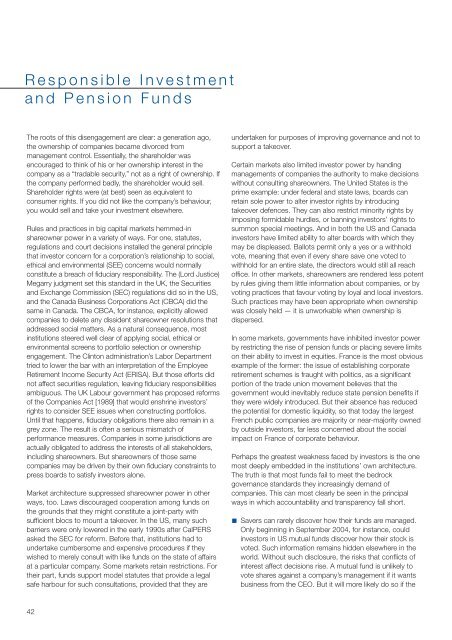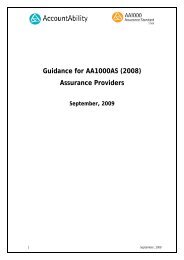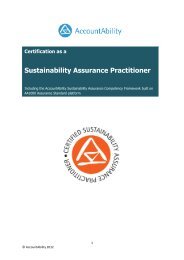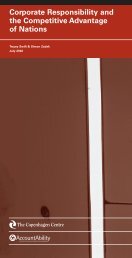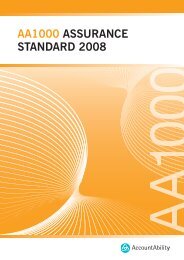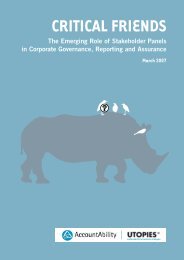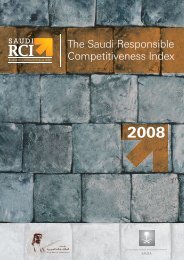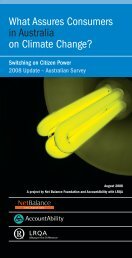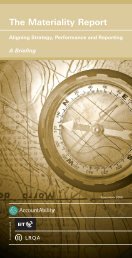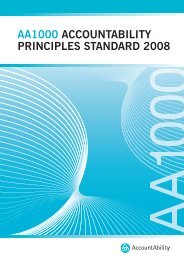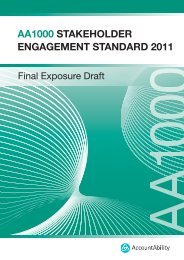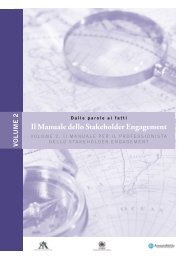Mainstreaming Responsible Investment - AccountAbility
Mainstreaming Responsible Investment - AccountAbility
Mainstreaming Responsible Investment - AccountAbility
You also want an ePaper? Increase the reach of your titles
YUMPU automatically turns print PDFs into web optimized ePapers that Google loves.
<strong>Responsible</strong> <strong>Investment</strong><br />
and Pension Funds<br />
The roots of this disengagement are clear: a generation ago,<br />
the ownership of companies became divorced from<br />
management control. Essentially, the shareholder was<br />
encouraged to think of his or her ownership interest in the<br />
company as a “tradable security,” not as a right of ownership. If<br />
the company performed badly, the shareholder would sell.<br />
Shareholder rights were (at best) seen as equivalent to<br />
consumer rights. If you did not like the company’s behaviour,<br />
you would sell and take your investment elsewhere.<br />
Rules and practices in big capital markets hemmed-in<br />
shareowner power in a variety of ways. For one, statutes,<br />
regulations and court decisions installed the general principle<br />
that investor concern for a corporation’s relationship to social,<br />
ethical and environmental (SEE) concerns would normally<br />
constitute a breach of fiduciary responsibility. The (Lord Justice)<br />
Megarry judgment set this standard in the UK, the Securities<br />
and Exchange Commission (SEC) regulations did so in the US,<br />
and the Canada Business Corporations Act (CBCA) did the<br />
same in Canada. The CBCA, for instance, explicitly allowed<br />
companies to delete any dissident shareowner resolutions that<br />
addressed social matters. As a natural consequence, most<br />
institutions steered well clear of applying social, ethical or<br />
environmental screens to portfolio selection or ownership<br />
engagement. The Clinton administration’s Labor Department<br />
tried to lower the bar with an interpretation of the Employee<br />
Retirement Income Security Act (ERISA). But those efforts did<br />
not affect securities regulation, leaving fiduciary responsibilities<br />
ambiguous. The UK Labour government has proposed reforms<br />
of the Companies Act [1989] that would enshrine investors’<br />
rights to consider SEE issues when constructing portfolios.<br />
Until that happens, fiduciary obligations there also remain in a<br />
grey zone. The result is often a serious mismatch of<br />
performance measures. Companies in some jurisdictions are<br />
actually obligated to address the interests of all stakeholders,<br />
including shareowners. But shareowners of those same<br />
companies may be driven by their own fiduciary constraints to<br />
press boards to satisfy investors alone.<br />
Market architecture suppressed shareowner power in other<br />
ways, too. Laws discouraged cooperation among funds on<br />
the grounds that they might constitute a joint-party with<br />
sufficient blocs to mount a takeover. In the US, many such<br />
barriers were only lowered in the early 1990s after CalPERS<br />
asked the SEC for reform. Before that, institutions had to<br />
undertake cumbersome and expensive procedures if they<br />
wished to merely consult with like funds on the state of affairs<br />
at a particular company. Some markets retain restrictions. For<br />
their part, funds support model statutes that provide a legal<br />
safe harbour for such consultations, provided that they are<br />
undertaken for purposes of improving governance and not to<br />
support a takeover.<br />
Certain markets also limited investor power by handing<br />
managements of companies the authority to make decisions<br />
without consulting shareowners. The United States is the<br />
prime example: under federal and state laws, boards can<br />
retain sole power to alter investor rights by introducing<br />
takeover defences. They can also restrict minority rights by<br />
imposing formidable hurdles, or banning investors’ rights to<br />
summon special meetings. And in both the US and Canada<br />
investors have limited ability to alter boards with which they<br />
may be displeased. Ballots permit only a yes or a withhold<br />
vote, meaning that even if every share save one voted to<br />
withhold for an entire slate, the directors would still all reach<br />
office. In other markets, shareowners are rendered less potent<br />
by rules giving them little information about companies, or by<br />
voting practices that favour voting by loyal and local investors.<br />
Such practices may have been appropriate when ownership<br />
was closely held — it is unworkable when ownership is<br />
dispersed.<br />
In some markets, governments have inhibited investor power<br />
by restricting the rise of pension funds or placing severe limits<br />
on their ability to invest in equities. France is the most obvious<br />
example of the former: the issue of establishing corporate<br />
retirement schemes is fraught with politics, as a significant<br />
portion of the trade union movement believes that the<br />
government would inevitably reduce state pension benefits if<br />
they were widely introduced. But their absence has reduced<br />
the potential for domestic liquidity, so that today the largest<br />
French public companies are majority or near-majority owned<br />
by outside investors, far less concerned about the social<br />
impact on France of corporate behaviour.<br />
Perhaps the greatest weakness faced by investors is the one<br />
most deeply embedded in the institutions’ own architecture.<br />
The truth is that most funds fail to meet the bedrock<br />
governance standards they increasingly demand of<br />
companies. This can most clearly be seen in the principal<br />
ways in which accountability and transparency fall short.<br />
Savers can rarely discover how their funds are managed.<br />
Only beginning in September 2004, for instance, could<br />
investors in US mutual funds discover how their stock is<br />
voted. Such information remains hidden elsewhere in the<br />
world. Without such disclosure, the risks that conflicts of<br />
interest affect decisions rise. A mutual fund is unlikely to<br />
vote shares against a company’s management if it wants<br />
business from the CEO. But it will more likely do so if the<br />
42


